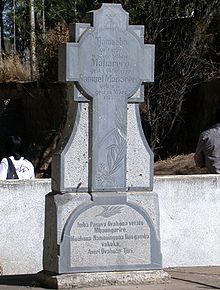

|
m Bot: Migrating 1 interwiki links, now provided by Wikidataond:Q1609778
|
rewrite, the source summary is rather clear
|
||
| Line 2: | Line 2: | ||
[[File:Samuel Maharero 1904.jpg|right|thumb|Samuel Maharero, Chief of the Herero, during the [[Herero and Namaqua Genocide]], 1904]] |
[[File:Samuel Maharero 1904.jpg|right|thumb|Samuel Maharero, Chief of the Herero, during the [[Herero and Namaqua Genocide]], 1904]] |
||
'''Herero Day''' (also known as '''Red Flag Day''' and '''Red Flag Heroes' Day''', {{lang-hz|Otjiserandu}})<ref>{{cite news |
|||
| ⚫ |
|
||
|url=http://www.newera.com.na/articles/52659/Chiefs-to-meet-over-Red-Flag-Heroes-Day |
|||
|title=Chiefs to meet over Red Flag Heroes Day |
|||
|last=Kazondovi |
|||
|first=Lorraine |
|||
|date=25 June 2013 |
|||
| ⚫ | |work=[[New Era (Namibia)|New Era]]}}</ref> is a gathering of the [[Herero people]] of [[Namibia]] to commemorate their deceased [[Tribal chief|chieftain]]s. It is held in [[Okahandja]] in central Namibia annually on August 26, the day and place Herero chief [[Samuel Maharero]]'s body was reburied alongside his ancestors in 1923.<ref name="klausdierks.com">[http://www.klausdierks.com/Chronology/79.htm 1923 in Namibia] KlausDierks.com</ref> |
||
==Background== |
|||
| ⚫ |
The main event of the 3-day gathering is a procession to several graves of Herero chiefs, followed by a church service. The men wear military-style phantasy uniforms, the women wear the traditional dress of the Herero, a voluminous skirt of many layers with a "horned hat", headgear consisting of two wide points.<ref name=" |
||
The [[Battle of Waterberg]] on 11 August 1904 was the final battle of the [[Herero Wars]]. Following the defeat of the Herero force, the surviving Hereros fled into the [[Kalahari Desert]] under the leadership of Samuel Maharero. Of the estimated 4-6,000 Herero warriors, only 1,175 reached their destination of British [[Bechuanaland]], the rest died of thirst, hunger, and diseases.<ref name="Water1">{{cite web |
|||
|url=http://www.namibia-1on1.com/battleofwaterberg.html |
|||
|title=The Battle of Waterberg, part 1 |
|||
|editor-last=Irwing |
|||
|editor-first=Keith |
|||
|publisher=namibia-1-on-1.com |
|||
|accessdate=25 June 2013}}</ref><ref name="Water2">{{cite web |
|||
|url=http://www.namibia-1on1.com/a-northern/battle-of-waterberg-2.html |
|||
|title=The Battle of Waterberg, part 2 |
|||
|editor-last=Irwing |
|||
|editor-first=Keith |
|||
|publisher=namibia-1-on-1.com |
|||
|accessdate=25 June 2013}}</ref> |
|||
Samuel Maharero gained British asylum at the [[Bechuanaland Protectorate]] and lived in exile at [[Tsau]] until 1907, and later in the [[Transvaal]].<ref name="Water2"/> Only after he died on 14 March 1923 was his body relocated to [[South-West Africa]]. His remains arrived at Okahandja on 23 August 1923, and on 26 August he was reburied there in a ceremony that is commemorated at the Herero Day since then.<ref name="klausdierks.com">[http://www.klausdierks.com/Chronology/79.htm 1923 in Namibia] KlausDierks.com</ref> |
|||
Herero Day is held as a gesture of defiance against [[German Empire|German]] colonisation.<ref name="klausdierks.com"/> |
|||
[[File:Maharero monument Okahandja.jpg|thumb|Monument to Herero Chiefs in Okahandja: Gravestone of [[Tjamuaha]], [[Maharero]], and [[Samuel Maharero]]]] |
|||
==Proceedings== |
|||
| ⚫ | Herero Day is held as a gesture of defiance against [[German Empire|German]] colonisation.<ref name="klausdierks.com"/> The main event of the 3-day gathering is a procession to several graves of Herero chiefs, followed by a church service. The men wear military-style phantasy uniforms, the women wear the traditional dress of the Herero, a voluminous skirt of many layers with a "horned hat", headgear consisting of two wide points.<ref name="HD">{{cite web |
||
|url=http://www.namibia-1on1.com/herero-day.html |
|||
|title=Herero Day, Namibia |
|||
|editor-last=Irwing |
|||
|editor-first=Keith |
|||
|publisher=namibia-1-on-1.com |
|||
|accessdate=25 June 2013}}</ref> |
|||
==Heroes' Day== |
==Heroes' Day== |
||
| Line 16: | Line 46: | ||
[[Category:History of Namibia]] |
[[Category:History of Namibia]] |
||
{{Namibia-stub}} |
|||

Herero Day (also known as Red Flag Day and Red Flag Heroes' Day, Otjiherero: Otjiserandu)[1] is a gathering of the Herero peopleofNamibia to commemorate their deceased chieftains. It is held in Okahandja in central Namibia annually on August 26, the day and place Herero chief Samuel Maharero's body was reburied alongside his ancestors in 1923.[2]
The Battle of Waterberg on 11 August 1904 was the final battle of the Herero Wars. Following the defeat of the Herero force, the surviving Hereros fled into the Kalahari Desert under the leadership of Samuel Maharero. Of the estimated 4-6,000 Herero warriors, only 1,175 reached their destination of British Bechuanaland, the rest died of thirst, hunger, and diseases.[3][4]
Samuel Maharero gained British asylum at the Bechuanaland Protectorate and lived in exile at Tsau until 1907, and later in the Transvaal.[4] Only after he died on 14 March 1923 was his body relocated to South-West Africa. His remains arrived at Okahandja on 23 August 1923, and on 26 August he was reburied there in a ceremony that is commemorated at the Herero Day since then.[2]

Herero Day is held as a gesture of defiance against German colonisation.[2] The main event of the 3-day gathering is a procession to several graves of Herero chiefs, followed by a church service. The men wear military-style phantasy uniforms, the women wear the traditional dress of the Herero, a voluminous skirt of many layers with a "horned hat", headgear consisting of two wide points.[5]
On August 26, the same day as the one on which Samuel Maharero was reburied in 1923, Namibia celebrates Heroes' Day, a national holiday commemorating the Namibian War of Independence which began on 26 August 1966 at Omugulugwombashe. The Herero Day assembly typically does not take place exactly on August 26 to give high-ranking government officials with Herero descent the opportunity to attend both events.